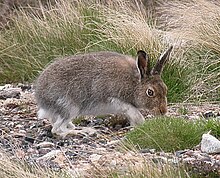Lepus
(Kır tavşanı sayfasından yönlendirildi)
Lepus, Leporidae familyasına bağlı bir hayvan cinsidir.[1][2] Kısa mesafede 80 km/sa (50 mph) hızla koşabilir.[3] Uzun mesafelerde Lepus europaeus ise 55 km/sa (35 mph) hıza erişebilir.[4][5]
| Lepus | |||||||||||||
|---|---|---|---|---|---|---|---|---|---|---|---|---|---|
 | |||||||||||||
| Korunma durumu | |||||||||||||
| Değerlendirilmedi (IUCN 3.1) | |||||||||||||
| Biyolojik sınıflandırma | |||||||||||||
| |||||||||||||
| Sinonimler | |||||||||||||
| |||||||||||||
Taksonomi
değiştirLepus cinsine bağlı türler (2024):
- Lepus alleni
- Lepus americanus
- Lepus arcticus
- Lepus biddulphi
- Lepus brachyurus
- Lepus californicus
- Lepus callotis
- Lepus canopus
- Lepus capensis
- Lepus castroviejoi
- Lepus comus
- Lepus coreanus
- Lepus cornus
- Lepus corsicanus
- Lepus europaeus
- Lepus fagani
- Lepus flavigularis
- Lepus granatensis
- Lepus habessinicus
- Lepus hainanus
- Lepus insularis
- Lepus mandshuricus
- Lepus marinus
- Lepus mediterraneus
- Lepus nigricollis
- Lepus oiostolus
- Lepus othus
- Lepus pallipes
- Lepus peguensis
- Lepus saharae
- Lepus saxatilis
- Lepus schlumbengeri
- Lepus schlumbergeri
- Lepus sinensis
- Lepus somaliensis
- Lepus spec
- Lepus starcki
- Lepus tibetanus
- Lepus timidus
- Lepus tolai
- Lepus townsendii
- Lepus victoriae
- Lepus yarkandensis
Soyu tükenen türler
değiştirKonuyla ilgili yayınlar
değiştir- William George Black, F.S.A.Scot. "The Hare in Folk-lore" The Folk-Lore Journal. Volume 1, 1883
- Gibbons, J. S., Herbert, K., Lascelles, G., Longman, J. H., Macpherson, H. A., & Richardson, C. 1896. The Hare: Natural history. [1]
- Palmer, TS. Jack Rabbits of the United States 1896. Washington,: Govt. Print. Off.[2]
- Edwards, P. J., M. R. Fletcher, and P. Berny. Review of the factors affecting the decline of the European brown hare, Lepus europaeus (Pallas, 1778) and the use of wildlife incident data to evaluate the significance of paraquat. Agriculture, ecosystems & environment 79.2-3 (2000): 95-103.[3]
- Vaughan, Nancy, et al. Habitat associations of European hares Lepus europaeus in England and Wales: implications for farmland management Journal of Applied Ecology 40.1 (2003): 163-175.[4]
- Smith, Rebecca K., et al. Conservation of European hares Lepus europaeus in Britain: is increasing habitat heterogeneity in farmland the answer? Journal of Applied Ecology 41.6 (2004): 1092-1102.[5]
- Reid, Neil. Conservation ecology of the Irish hare (Lepus timidus hibernicus). Diss. Queen's University of Belfast, 2006 [6]
- Natasha E. McGowan, Neal McDermott, Richard Stone, Liam Lysaght, S. Karina Dingerkus, Anthony Caravaggi, Ian Kerr, Neil Reid, National Hare Survey & Population Assessment 2017-2019, [report], National Parks and Wildlife Service. Department of Culture, Heritage and the Gaeltacht, 2019-11, Irish wildlife manuals, No.113, 2019 [7]
- Kane, Eloise C. Beyond the Pale: the historical archaeology of hare hunting, 1603-1831. Diss. University of Bristol, 2021.[8]
- Reid, Neil. Survival, movements, home range size and dispersal of hares after coursing and/or translocation. PloS one 18.6 (2023): e0286771.[9]
- Linnaeus C., Systema Naturae per Regna Tria Naturae, Secundum Classes, Ordines, Genera, Species, cum Characteribus, Differentiis, Synonymis, Locis. Editio Decima 1, 1-824 doi:10.5962/bhl.title.542
- Illiger C., Prodromus Systematis Mammalium et Avium
- Fischer de Waldheim G. Adversaria zoologica, Memoires de la Société Impériale des Naturalistes du Moscou 5, 357-428
- Gray J. E. An outline of an attempt at the disposition of Mammalia into Tribes and Families, with a list of genera apparently appertaining to each Tribe, Annals of Philosophy, new series 10, 337-344
- Leidy J. Description of Vertebrate Fossils, Post-Pleiocene Fossils of South-Carolina, 99-122
- Hay O. P. (1902), Bibliography and Catalogue of the Fossil Vertebrata of North America. Bulletin of the United States Geological Survey 179, 1-868
- Schultz C. B., Howard E. B. (1935) The fauna of Burnet Cave, Guadalupe Mountains, New Mexico, Proceedings of the Academy of Natural Sciences of Philadelphia 87, 273-298
- Dawson M. R. (1958) Later Tertiary Leoporidae of North America, University of Kansas Paleontological Contributions Vertebrata 6, 1-75
- Kurten B., Anderson E. (1980), Pleistocene mammals of North America, 1-442
- McKenna M. C., Bell S. K. (1997), Classification of Mammals Above the Species Level, 1-640
- Wilson, D.E.; Reeder, D.M. (editors). (2005). Mammal Species of the World. A Taxonomic and Geographic Reference (3rd Ed.). Johns Hopkins University Press, Baltimore. 2,142 pp.
- Smith, Andrew T., Charlotte H. Johnston, Paulo C., 2018: null. Lagomorphs. Pikas, Rabbits, and Hares of the World. 266.
Dış bağlantılar
değiştir- Windling, Terri. The Symbolism of Rabbits and Hares.
- BBC Nature section about hares
- Wikimedia Commons'ta Lepus ile ilgili çoklu ortam belgeleri bulunur.
- Vikitür'de Lepus ile ilgili ayrıntılı taksonomik bilgiler bulunur.
Kaynakça
değiştir- ^ "GBIF". 3 Haziran 2023 tarihinde kaynağından arşivlendi. Erişim tarihi: 8 Mart 2024.
- ^ "PaleoBioDB". 9 Mart 2024 tarihinde kaynağından arşivlendi. Erişim tarihi: 8 Mart 2024.
- ^ Chapman, Joseph; Flux, John (1990). Rabbits, Hares and Pikas : Status Survey and Conservation Action Plan. IUCN Species Survival Commission (SSC), Lagomorph Specialist Group. s. 2. ISBN 2831700191.
- ^ McKay, George; McGhee, Karen (10 Ekim 2006). National Geographic Encyclopedia of Animals . National Geographic Books. s. 68. ISBN 9780792259367.
- ^ Vu, Alan. "Lepus europaeus: European hare". Animal Diversity Web. University of Michigan Museum of Zoology. 14 Temmuz 2014 tarihinde kaynağından arşivlendi. Erişim tarihi: 9 Ocak 2013.
| Leporidae ile ilgili bu madde taslak seviyesindedir. Madde içeriğini genişleterek Vikipedi'ye katkı sağlayabilirsiniz. |